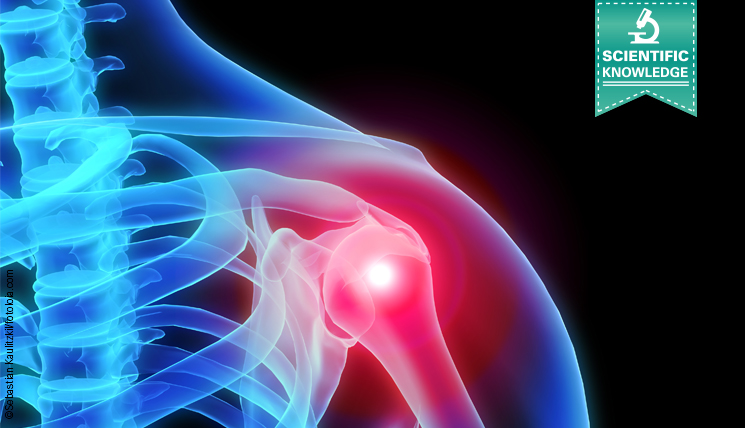Rheumatoid arthritis (RA) is an autoimmune disease characterised by chronic inflammation of the joints. Its development is stimulated by genetic and environmental risk factors.
It is not very long ago that the relevant autoantigens in RA were identified. So-called citrullinated proteins (they contain the amino acid citrulline) are one of possibly several target antigens of the autoimmune reaction which results in the production of anti-citrullinated protein autoantibodies (ACPA) [1].
Citrulline is not amongst the standard amino acids. It is only produced after protein synthesis by modification of the amino acid arginine. This conversion is known citrullination and is catalysed by enzymes of the peptidyl-arginine deiminase (PAD) family. The process has consequences for important characteristics of the protein such as net charge, three-dimensional conformation and antigenicity. Citrullination takes place in healthy tissues, but is presumed to be also part, or result of general inflammatory processes.
Increased amounts of citrullinated proteins have now also been found in the synovial fluid. The modification of amino acids leads to the formation of entirely new epitopes. The immune system of the patients then reacts to these epitopes with the creation of ACPA. This immune response, rather than the mere presence of citrullinated proteins, is characteristic of RA [1].
Symptoms of rheumatoid arthritis
The risk factors which trigger the autoimmune reaction and development of RA in the affected persons encompass hereditary, as well as external factors.
Genetics
Some genetic variants are especially strongly associated with the presence of ACPA. They code for so-called HLA-DR molecules (HLA-DR1, -DR4 and -DR10). Some particular alleles of these genes are considered important risk factors for RA – they are summed up under the term “shared epitopes” due to their common sequence motif. HLA-DR molecules are found on the surface of specialised cells and are required for antigen presentation. They make selected regions of the citrullinated proteins visible for immune cells, which produce ACPA against the epitopes identified as “foreign”.
Environment
An environmental or external factor which is strongly associated with RA is smoking tobacco. It is, however, still virtually unknown in which way smoking contributes to the disease. One theory is that the toxic components of the tobacco stimulate an inflammation which leads to an increased synthesis of citrullinated proteins and the following immune reaction.
Also infections might contribute to the development of RA in a similar way. Infections with the bacterium Porphyromonas gingivalis are here especially important. P. gingivalis afftects the oral cavity and is the main cause for periodontitis, an inflammation of the gums or roots of the teeth. When comparing RA with an infection with P. gingivalis, the following observations can be made: 1) The diseases often occur together. 2) RA and periodontitis often show severe inflammatory reactions which also affect the bones. 3) The diseases are in part associated with the same genetic and environmental risk factors (HLA-DR, smoking). 4) P. gingivalis synthesises an enzyme with PAD activity which is able to citrullinate proteins of the bacterium, but also proteins of human cells.
Due to these characteristics, an infection with P. gingivalis might stimulate the autoimmune reaction against citrullinated proteins in persons who are prone to RA [1, 2].
Diagnostic tests and specific antigens
Diagnostic tests of the first and second generation for the detection of ACPA use cyclic citrullinated peptides (CCP) as substrate. These do not correspond to the proteins citrullinated in vivo in RA [1, 3], but bind the antibodies with high specificity and very good sensitivity. Anti-CCP ELISAs are the most important test systems in serological diagnostics of RA, with a specificity of approximately 98% and a sensitivity of over 70%. The artificial peptides cannot, however, provide information on the cause and pathogenesis of the disease.
Only slowly is research approaching the true identity of the autoantigens citrullinated in vivo in the joints of RA patients, such as fibrinogen/fibrin, vimentin, collagen type II, fibronectin and α-enolase. Autoantibodies against the immunodominant citrullinated areas of the proteins form part of the ACPA population which is, as discovered in the meantime, very heterogeneous [1, 4]. It is now being investigated in which way they are involved in the development and pathogenesis of RA.
The role of citrullinated a-enolase in RA
Approximately 40% of patients show autoantibodies against a citrullinated epitope of α-enolase, the CEP-1 peptide, which are highly specific for the disease (97%). Interestingly, CEP-1 shows a remarkably high sequence homology to the corresponding peptide of the bacterial α-enolase of P. gingivalis. Therefore, human anti-CEP-1 antibodies are able to recognise and bind recombinant, in vitro–citrullinated P. gingivalis enolase. This has led to the hypothesis of molecular mimicry as a cause of RA: In order not to be identified as foreign by the immune system, P. gingivalis has an α-enolase which is similar to the human α-enolase. Due to the similarity, the bacterial PAD might citrullinate both the P. gingivalis enolase and the human enolase, which sensitive persons subsequently produce antibodies against. Alternatively, there is the possibility that the immune response is really primarily directed against the bacteria and their citrullinated proteins, amongst others α-enolase, whereby the formed autoantibodies later cross-react with the human CEP-1 in the joints of RA patients.
Further studies are necessary to understand the molecular mechanisms which might connect P. gingivalis infections with RA-specific autoimmunity against citrullinated peptides [2].
In cooperation with Prof. Venables (Kennedy Institute of Rheumatology, University of Oxford), EUROIMMUN has developed a commercial, CE-approved ELISA for the detection of anti-CEP-1 antibodies as a result of increasing evidence that CEP-1 plays a role in the pathogenesis of RA.
[1] Wegner N et al., 2010, Immunol Rev 233: 34-54. [2] Lundberg K et al., 2010, Nat Rev Rheumatol 6(12): 727-730. [3] Wiik A et al., 2010, Autoimmun Rev 10(2): 90-93. [4] Lundberg K et al., 2013, Ann Rheum Dis, 72:652-658.

